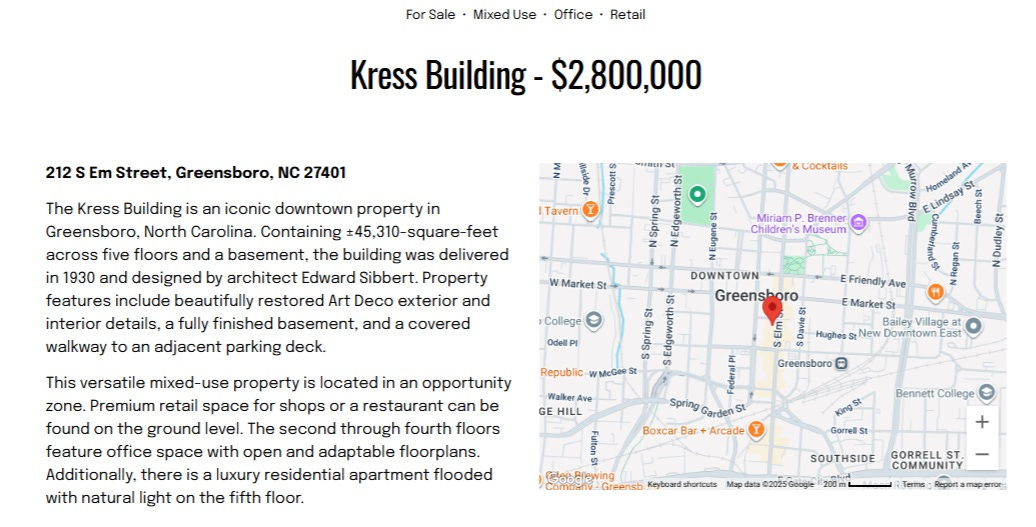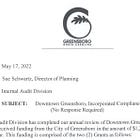The Kress Lomax Cover-Up; How Greensboro’s Press Ignores a Web of Power, Money and Backroom Deals
A vacant building, a powerful councilman, a major donor and a newsroom that refuses or doesn't know enough to connect the dots
If you want to understand how power really works in a midsize American city, you don’t look at the press releases or the ribbon-cuttings. You look at a vacant building.
In Greensboro, North Carolina, that building is the historic Kress Building on South Elm Street, sitting empty for years in the heart of downtown. And a recent, anodyne news article about its future is a masterclass in how local press fails to inform the public by not knowing and/or ignoring the tangled web of relationships right in front of it.
The Greensboro News & Record just published a piece on downtown development;
New entertainment districts in downtown Greensboro? New plan calls for that and more
Downtown Greensboro Inc. has unveiled its GSO 35 plan, laying out objectives for growing the downtown area over the next decade.
One of the key initiatives is to energize Elm Street, and to do this the plan calls for revitalizing empty store fronts and historic buildings on Elm.
Councilman Zack Matheny, president of DGI, said DGI was in talks with the owner of the Kress Building, which has been vacant for years, about the building’s future.
“There’s a lot going on with the Kress building right now,” Matheny said.
https://greensboro.com/news/local/business/article_7171d1b9-cb59-4c98-8a01-bee714ae7362.html
Again, City Councilman Zack Matheny, who also serves as the paid president of the downtown advocacy group Downtown Greensboro, Inc. (DGI), offered the tidbit;
“There’s a lot going on with the Kress building right now,” Matheny said, noting DGI was in talks with the owner.
To the average reader, this is a bland update. But to anyone with a passing knowledge of Greensboro’s political landscape, this sentence should have set off alarm bells. The reason most Greensboro residents don’t know what they should about how their city is run is simple, the press doesn’t tell them.
Let’s connect the dots the News & Record refused or didn’t know to;
Dot 1: The “Owner” is a former DGI Director and Matheny Donor
The News & Record report identifies the Kress Building’s owner only as an anonymous party. But public records are clear. The building was purchased in 2000 by a partnership of Bruce Cantrell and John Lomax, who turned its rooftop into Lomax’s personal penthouse and an event space.
Who is John Lomax? He’s not just any property owner. He is a former director of DGI, the very organization led by Councilman Matheny. This isn’t a simple negotiation; it’s a conversation between a city official who lobbies the City for economic development money and his buddy about a prime piece of real estate for sale at a 50% discount.
The plot thickens with a quick search of North Carolina campaign finance records. In July 2025, just days before the News & Record article was published, John Lomax made a $1,000 contribution to “MATHENY FOR COUNCIL.” He also gave the same to Richard Beard, who was a business partner of another key player, real estate broker Sam Simpson, brother of PGA golfer Webb Simpson and also a former DGI board member when his firm was named Simpson Schulman & Beard, as in Richard, who’s running for City Council At-Large this year.
The News & Record story on GSO35 doesn’t mention Simpson Commercial currently has the Lomax property listed for $2,800,000, which was assessed at $5,659,200 as of March 19, 2021;
212 S Elm St|
Greensboro, NC 27401
The Historic S.H. Kress & Co Building · Office Property For Sale
https://www.loopnet.com/Listing/212-S-Elm-St-Greensboro-NC/22519069/
And now;
https://www.simpsoncre.com/listings/kress-building
$5,659,200 - $2,800,000 = $2,895,200 less in 2025 than 2021
50.5% less than 2021
So, to recap: A city councilman who is also the president of DGI is negotiating a taxpayer funded deal with a former DGI director who is also a recent campaign donor who may be a bit desperate for a taxpayer subsidized bailout for his empty building, and Sam Simpson is the listed realtor for the property.
The News & Record’s omission; This critical conflict of interest goes unmentioned.
Dot 2: A Decade-Long Pattern of Insider Dealing;
This isn’t a one-off. The relationship between Matheny, Lomax, Simpson and the DGI network is a matter of public record, detailed for years by local bloggers and alternative outlets. A quick dive into the archives reveals a consistent pattern:
2014: Questions were raised about a “New City of Greensboro Give Away Program” that John Lomax and broker Sam Simpson found out about before the general public;
New City of Greensboro Give Away Program John Lomax and Sam Simpson knew about before the general public
http://hartzman.blogspot.com/2014/01/new-city-of-greensboro-give-away.html
Present Greensboro City Council At-Large candidate Denise Turner-Roth and Mayor Nancy Vaughan were also on DGI’s board at the time along with E. Durant Bell. Bell & Company’s Bell Foundation, Zack Matheny’s former employer, was a $5,000.00 per year DGI financial supporter at the time. Bell is now the GSO35 Steering Committee Chair;
Durant Bell reportedly has an ownership interests in the Wells Fargo Tower, the News & Record site and the Triad Stage property with DGI board member Arthur Samet.
2014: Then Councilman Matheny again tried the same thing only in a different way;
1/18/14; Zack Matheny shoving an incentive for his friends and campaign contributors down Greensboro taxpayer’s throats
https://hartzman.blogspot.com/2014/01/zack-matheny-shoving-incentive-for-his.html
2014: Lomax was revealed to have submitted a public records request to the city concerning a property deal (the Gerbings building) he sought to profit from but didn’t after activist interventions;
City of Greensboro IFYI; John Lomax requests info on the Gerbings deal which he sought to profit from
http://hartzman.blogspot.com/2014/01/city-of-greensboro-ifyi-john-lomax.html
For over a decade, the same names, Matheny, Lomax, Simpson, Beard, Carroll, Zimmerman etc… appear at the center of questions about opaque incentives, insider information, and the blending of public office with private gain.
This historical context, essential for understanding the significance of the current “talks,” is entirely absent within the News & Record’s omissions.
Dot 3: The Incestuous Board
Who oversees DGI? When a new board was formed in 2014, its members included John Lomax, Mayor Nancy Vaughan, the City Manager, Guilford County’s Manager, a Roy Carroll employee and, you guessed it, Sam Simpson, whose firm stood to benefit directly from downtown development deals Zack lobbied for.
This is the “closed-loop” system of governance; City officials sit on the board of a organization that negotiates with political donors and former city officials, all covered by a press that reports on the events in isolation, near total ignorance or purposeful propaganda.
The story here is not that Councilman Matheny is talking about providing public monies to a property owner. The story is who that property owner is, what their financial relationship is and the long history of similar dealings.
By publishing a superficial update that ignores these facts, the Greensboro News & Record, led by Executive Editor Camdyn Bruce and Managing Editor Dimon Kindrick Holmes, becomes a passive participant in the obfuscation. They are treating a potential major integrity issue as an economic development booster story.
This failure to assimilate information and provide context is a dereliction of duty. It allows a system to flourish where the same individuals rotate between roles as public officials, downtown boosters, political donors and beneficiary developers, all without the scrutiny an informed electorate requires.
The Kress Building remains vacant, but the real vacancy is in the newsrooms that won’t tell the public the full story of what’s happening inside it.
The core issue revolves around the practice of using public funds to attract private investment, a competitive but contentious strategy in economic development championed by Richard Beard amongst others for years. When Matheny says “investors are looking at anything that will come,” it signals that companies are actively soliciting bids from communities, forcing them into a bidding war. The “anything” they seek are taxpayer-funded incentives, such as tax abatements, cash grants, and infrastructure upgrades, which effectively lower the companies’ costs and risks. While proponents argue these deals are necessary investments to create jobs and stimulate local economies, critics contend they represent a “race to the bottom,” where communities may overpay, sacrificing vital public revenue for promises that can sometimes fall short. This creates a fundamental tension between the immediate desire to secure a project and the long-term question of whether the benefits truly justify the public subsidy, raising concerns about corporate welfare and the opportunity cost of foregone investments in public services.
When City Councilwoman Sharon Hightower asked “The question is how much?” and the CEO, Zack, replied with “How much you got?”, the polite façade of negotiation dropped away to reveal a raw power dynamic.
What it really meant was that the negotiation was no longer about the city judiciously weighing the cost of an incentive against a specific public benefit. Instead, it became a blunt demand for the maximum possible subsidy. Hightower’s question, while direct, still operates within a framework of finding a reasonable price. Zack’s retort, however, was a classic and somewhat aggressive negotiating tactic that frames the city’s resources as an open wallet to be emptied. It implied that the investors’ commitment is not based on the project’s inherent merits or a fair partnership, but purely on the size of the taxpayer-funded offer, suggesting they are willing to take as much as the city is desperate enough to give. This exchange highlights the fear that such incentives are less about fostering mutual growth and more about corporations extracting wealth from communities.
Related;
“Here’s the full list of the new DGI board”
Sam Simpson with brokerage Simpson Schulman & Beard;
Al Leonard, The Carroll Cos.;
Nancy Vaughan, Greensboro Mayor;
Denise Turner-Roth (and Jim Westmoreland in her stead), Greensboro City Manager;
http://hartzman.blogspot.com/2014/01/heres-full-list-of-new-dgi-board.html
.
11/27/12; Did Downtown Greensboro Inc. get $250,000 to fund $25,000 grants that will most likely benefit Downtown Greensboro Inc’s members?
https://hartzman.blogspot.com/2012/11/did-downtown-greensboro-inc-get-250000.html
.
12/26/13; Did Zack Matheny sell Greensboro taxpayer money to run for congress?
https://hartzman.blogspot.com/2013/12/did-zack-matheny-sell-greensboro.html
.
On Zack Matheny’s crooked incentive package for his friends in Downtown Greensboro
Zack denies Sam Simpson making any money on the deal.
Yes Weekly, 11/16/2011; On John Lomax’s “reimbursement” for $217,812
https://hartzman.blogspot.com/2014/01/yes-weekly-11162011-on-john-lomaxs.html
.
3/1/10; On the Greensboro Partnership, DGI, the News & Record, Greensboro’s City Council and conflicts of interest
https://hartzman.blogspot.com/2010/03/on-greensboro-partnership-dgi-news.html
Disclaimer: The analysis in this article interprets public statements to explore the common strategies in economic development negotiations. The views expressed are those of the analysis and not necessarily factual assertions about the individuals’ intentions. The interpretations offered are those of the author and are not intended as definitive statements of fact regarding the participants’ motives. The actual negotiations involve complex, non-public details that are not fully captured here. Readers are encouraged to consult primary sources for official statements.







